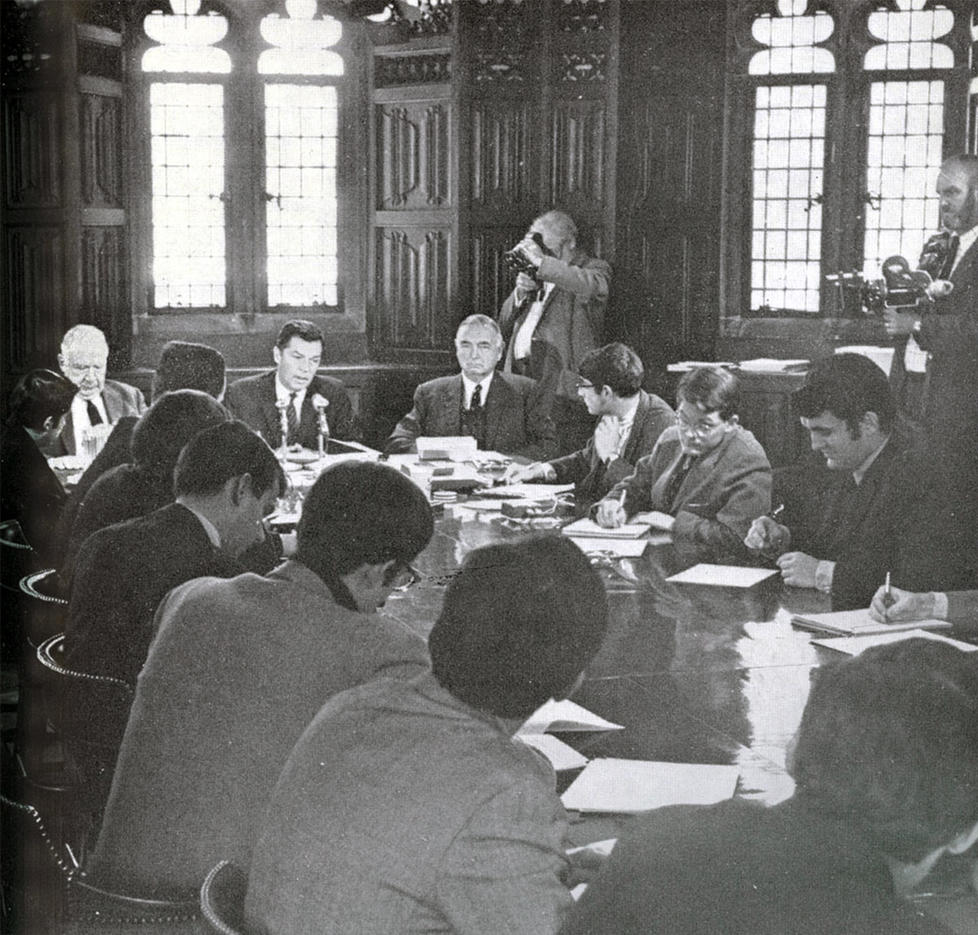50 Years Ago, Princeton Trustees Voted to Admit Women as Undergraduates
Remembering the University’s “largest single decision” of the 20th century — and alumni responses to it
This year will include a series of anniversaries related to the start of undergraduate coeducation at Princeton, beginning with Jan. 11, the 50th anniversary of the University trustees’ vote approving the admission of undergraduate women, “in principle,” by a 24-8 margin. The trustees called it “the largest single decision that has faced Princeton in this century.” At a press conference the following day, President Robert Goheen ’40 *48 had few details and cautioned that the admission of women in 1969 was “not likely, given the number of problems of facilities and finances.” But women would indeed be part of the incoming Class of 1973, along with transfer students who entered as sophomores, juniors, and seniors.
In PAW’s student column, “On the Campus,” Robert K. Durkee ’69 reported on the initial reaction from current students: “In the opinion of most undergraduates, the trustees did nothing more than endorse an inevitability of coeducation that most took for granted. … But, in the words of The Daily Princetonian, the trustees ‘copped out’ on the really important decisions,” such as how many women would be admitted, when they would arrive, and what changes to facilities would be made to accommodate coeducation.
After the trustees’ vote, alumni voiced their views in letters to the editor of PAW, continuing a conversation that had been simmering since September 1968, when a committee led by economics professor Gardner Patterson published its report, “The Education of Women at Princeton.” The committee, asked by Goheen and the trustees to investigate the “desirability and feasibility” of coeducation, concluded that “Princeton would be a better university if women were admitted to the undergraduate college.” (Women had already begun attending the Graduate School, and a limited number were enrolled as undergrads in the critical-languages program.)
READ MORE: When Women Came to Princeton
Former Dean of the College Nancy Weiss Malkiel on the struggle for coeducation
Reactions included a mix of indignation, vitriol, snark, and generational division. On one extreme was the view of E.S. Hubbell 1920, who argued that only in a single-sex environment “can a young man develop and grow to a well-balanced state of manhood of spirit, friendships, and self-sufficiency, a state of red-blooded manhood.” (Hubbell added in a postscript that he was “not a woman hater” and in fact had a wife and two daughters.) On the other side were alumni like Clark M. Simms ’53, who, observing the “dyspepsia among many alumni, especially older alumni,” suggested that PAW divide itself into two editions: one describing contemporary Princeton “as accurately as possible,” and another that focused on “winning athletic seasons, the polished and gentlemanly aura of smoothly run bickers, and senior step singing.”
Michael Zeilik II ’68 argued for coeducation for competitive reasons, writing that it would “not only improve the daily life of the real Princeton, but will also renovate Princeton’s image, making it unquestionably more attractive to the talented young scholars Princeton most wants and needs.” Raleigh Hansl Jr. ’39 didn’t reject coeducation but balked at the expanding University, arguing to “keep Princeton the kind of place where every student has the chance to graduate in the best damn class ever produced by his (or her) dearly beloved Old Nassau.”
READ MORE: Trials of the Co-ed 100
A 1973 PAW essay by Jane Leifer ’73
There were formal efforts to block that path to coeducation: In March, two months to the day after the trustees’ vote, a group called the Alumni Committee to Involve Ourselves Now (Action) held its own press conference, with spokesman George Hamid ’40 expressing the group’s “anxiety over the headlong rush into coeducation,” among other concerns. James Karl Baker ’67 responded to Action by proposing that a sociology student scientifically survey alumni attitudes toward coeducation “so that we may end this ‘minority rule’ of antiquated crackpots and demonstrate to the world the true spirit of modern academia.”
By late May, as the final all-male class prepared for Commencement, PAW’s coeducation letters had begun to taper off, with David T. Stanley ’37’s brief dispatch in the May 27 issue summarizing the viewpoint that would ultimately prevail:
“The Patterson Report said it well; President Goheen has said it well and often; a strong majority of the trustees have said it: IF PRINCETON IS TO CONTINUE TO BE A FIRST-CLASS EDUCATIONAL INSTITUTION, IT MUST ADMIT WOMEN.
“Now let’s just go ahead and do it, as fast and as well as we can.”












1 Response
Jewel Brown Hill ’77
6 Years AgoA Difficult Atmosphere
It was interesting to read about the debate that went on before Princeton became coed. I was a sophomore transferee from Cornell and graduated cum laude in 1977. Princeton was a significant and difficult atmosphere to adjust to as a Black, married 25-year-old practicing Sunni Muslim (a path I no longer follow), coming from the inner city of Brooklyn! Fortunately I enjoyed learning, but was very aware of the discomfort and awkwardness my presence often generated both on and off campus.
It's good to see the strides the University has taken in the area of race relations/cultural diversity, as well as the academic and structural changes that illuminate the impact of racism on the larger society.
I am grateful for my Princeton experience with all its knocks and bumps ... and no longer find it awkward to say that I am a Princeton graduate.